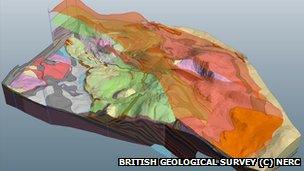Model made of 'thrust belt' geology in Assynt
- Published

BGS said it hoped the model would help understanding of the geological feature
A 3D interactive model has been created of the geology in a part of the north west Highlands.
The British Geological Survey (BGS) model reveals a section of what is known as the Assynt Culmination in the Moine Thrust Belt, external.
It was formed when two ancient continents collided about 430 million years ago.
BGS has made the model available on its website and said it hoped it would aid understanding of the geology.
The organisation said: "The Moine Thrust Belt is one of the iconic structures of the Caledonian Orogeny that we have in the Highlands of Scotland.
"It has been researched for a century and more.

The model reveals the geology of part of the Moine Thrust Belt
"BGS have now created a 3D interactive model of the northern part of the Assynt Culmination in the thrust belt."
Massive sheets
The Moine Thrust forms part of the North West Highland Geopark.
The park is part of a European network of areas with important geology. It has rocks of more than 3,000 million years old.
According to the geopark, the collision of the two ancient continents pushed massive sheets of rock 62 miles (100km) to the west creating the Moine Thrust and many of Scotland's mountains.
The effects of this thrusting can be seen at Knockan Crag, Traligill, Loch Glencoul, Foinaven, Faraid Head, Eriboll and Whiten Head.
- Published13 August 2012